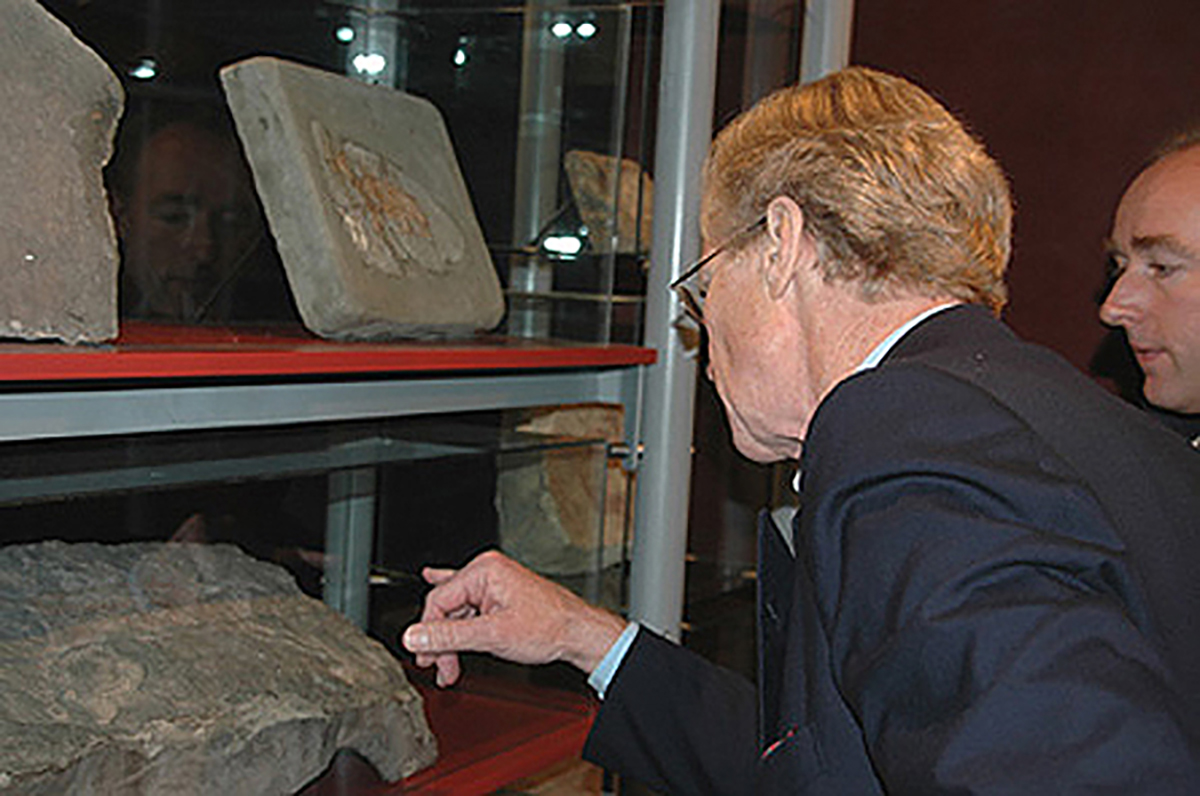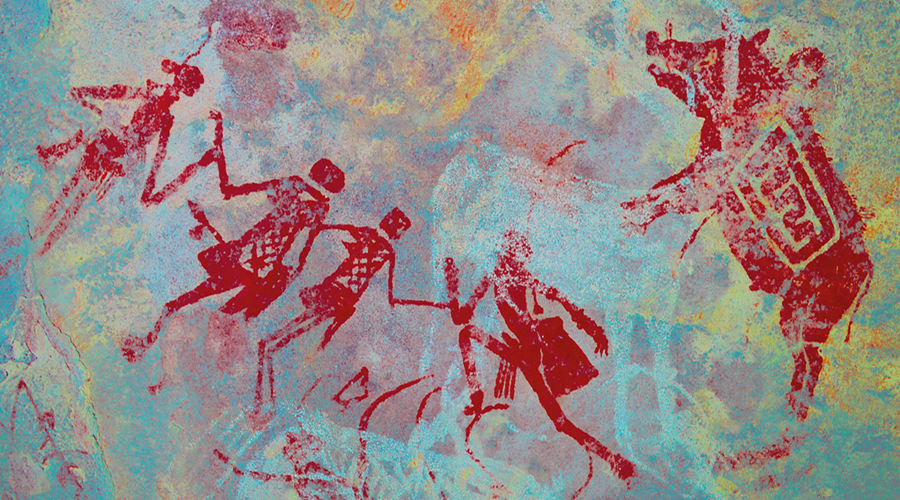


In June 2007 the Bradshaw Foundation visited the Origins Centre in Johannesburg, South Africa. Damon de Laszlo, Chairman of the Bradshaw Foundation, and its Editor, Peter Robinson, flew to South Africa to meet Dr. Ben Smith, Director of the Rock Art Research Institute and a member of the Bradshaw Foundation's Advisory Board. The purpose of the field trip was to gather material for our latest iLecture film on San rock art. In so doing, we were offered the opportunity and privilege to meet Dr. Geoff Blundell, Director of the recently opened Origins Centre - one of the world's finest museums of archaeology and anthropology.



The San rock art of southern Africa is perhaps the best known of all of Africa's rock art. It is also amongst the best understood. The 'Rosetta Stone' of this rock art is located at Game Pass Shelter in the Drakensberg Mountains, where Professor David Lewis-Williams, by studying one panel in particular , gained new and invaluable insights on the meaning of San rock art.
We were also able to visit the new Kamberg San Rock Art Interpretation Centre, located below the lofty Game Pass Shelter.
Here, we were reminded that for decades researchers believed that the art was simply a record of daily life or a primitive form of hunting magic. Those were the days of 'gaze and guess', when it seemed that the longer one gazed at the art, the better ones guess would be as to its meaning.
Now, however, by linking specific San beliefs to recurrent features in the art, researchers have been able to crack the code of San rock art.
What has been revealed is one of the most complex and sophisticated of all the world's symbolic arts. Far from a general view of life, the art focuses on a particular part of San experience: the spirit world journeys and experiences of San shamans.
Thus we see many features from the all important trance dance, the venue in which the shamans gained access to the spirit world. We see dancers with antelope hooves showing that they have taken on antelope power, just as San shamans describe in the Kalahari today. Then, we see shamans climbing up the so-called 'threads of light' that connect to the sky-world. We see trance flight.
To show their experiences, the artists also used visual metaphors such as showing shamans 'underwater' and 'dead'. These capture aspects of how it feels to be in trance. The artists also show their actions in the spirit world, such as their capturing of the rain animal, their activation of potency for use in healing or in fighting off enemies or dangerous forces.
But, the art was far from just a record of spirit journeys. Powerful substances such as eland blood were put into the paints so to make each image a reservoir of potency. As each generation of artists painted or engraved layer upon layer of art on the rock surfaces they were creating potent spiritual places.
A MUSEUM IN AFRICA FOR THE PEOPLE OF THE WORLD
Dr. Geoff Blundell, Director
The Origins Centre offers visitors a unique experience of Africa's rich, complex and sometimes mysterious past. Combining cutting-edge technology with the creative vision of South Africa's foremost artists, the narrative structure of the museum takes visitors through an extraordinary journey of discovery.
The journey begins with the origins of humankind in Africa and then moves through the development of art, symbolism, technology - the very things that give us our humanity - on the continent.The journey then continues through the destruction of the great and diverse southern African rock art traditions - the world's oldest continuous art forms - at the hands of colonists before ending, more positively, with the re-discovery of these ancient masterworks in a contemporary world.
Unashamedly Africa-centric, the Origins Centre seeks to restore the continent to its rightful place in history - as the place where everything that makes us who we are today originated.
ORIGINS CENTRE - RECURRENT MOTIFS
The 16 display areas are linked by 2 motifs, both drawn from current understandings of San rock art.
MOTIF 1 - A VEIL
It is widely accepted today that the rock surface on which San artists painted was a conceptual veil between this world and that of the spirits. This motif manifests itself in the design of the building: running through all three levels of the building is an archive space in which the Rock Art Research Institute's valuable items are housed. An architectural and design analogy has been drawn between this archive space and the rock surface veil.
MOTIF 2 - A THREAD
A particularly well-known image of San rock art is that of a thin, red line often fringed by white dots. These lines have been identified as the threads of light that link the real world to the world of spirits; the lines also link rock art sites and they too weave in and out of the rock surface or veil.
THE EXHIBITS
COURTYARD AREA
A tranquil indigenous garden with examples of plants used by ritual specialists throughout southern Africa.
WELCOME HOME - HUMANITY'S ORIGINS IN AFRICA
All humans are linked to Africa as it is here that our ancestors evolved.
A world map, hand-woven by Walter Oltmann, illustrates the movement of humankind from southern Africa into all areas of the world.
OUT OF AFRICA - THERE IS ALWAYS SOMETHING NEW
Ongoing archaeological discovery indicates technological and artistic innovations originating from Africa between 2.6 million years and 60 000 years ago. Here we have early African lithic tools, a hologram of one of the Blombos Ochre pieces, and a Pepper's Ghost exhibit (optical illusion) of the cave at Blombos, with the archaeologist Chris Henshilwood explaining that the origins of humans and humanity are to be found in Africa.
AFRICA'S ANCIENT PAST - THREADS OF EVIDENCE FOR 'OUT OF AFRICA'
5 columns, each containing a stratigraphic sequence represent the archaeological sequence from 5 global areas, and illustrate Africa's vast history compared to the other continents. The display panels consider the various sources of evidence for the 'out-of-Africa' hypothesis: palaeontology, archaeology, art, genetics, and linguistics.
AFRICA'S CREATIVE EXPLOSION - FURTHER DEVELOPMENTS IN ART & TECHNOLOGY
Innovation and diversification marked the period from 60 000 years ago until the mid 19th century. A short film on the origins of humans and humanity in Africa, summarizes areas 1 through 5. The wall of lithic artefact continues.
THE SAN OF SOUTHERN AFRICA
The San (Bushmen) are responsible for the technological and artistic innovations of the Middle and later Stone Ages. Examine the sophisticated technology of hunting and gathering, and examples of flourishing art through objects, some of which were traded in a gift-exchange system.
PEOPLE OF THE ELAND ITHE ANTELOPE AS CENTRAL SYMBOL
IN SAN THOUGHT
The eland plays a prominent role in San ritual, belief and rock art.
Eland are the most frequently depicted animals in the rock art of certain areas, and the symbolic significance is apparent in the beliefs and ritual practices of diverse San groups. Several important painted stone pieces can be seen, including the Mapote Stone and the Klipfontein Stone.
KLIPFONTEIN STONE
An important painted stone piece from the Eastern Cape Province.
The depiction of a dying eland alongside flying antelope with bleeding noses on this stone suggest that images of hunting in San rock art depict metaphorical hunts for supernatural energy rather than real hunts for meat.
DANCE OF DEATH, DANCE OF LIFE - THE GREAT DANCE AS THE CENTRAL RITUAL OF SAN LIFE
During the dance the dying eland releases supernatural energy, which is harnessed by the dancers to enable them to temporarily enter the spirit world. The experiential film in this room illustrates insight into the emotional and physical turmoil, the importance of the dance and.its associated symbols in San Rock art.
INTO THE SPIRIT WORLD - THE TIERED COSMOS IN SAN THOUGHT
Landscapes are meaningful and complex to the San. Access to the Spirit World was gained through natural features in the landscape such as waterholes, holes in termite mounds, and cracks in rock surfaces. Continue upstairs to the temporary exhibition, or downstairs to continue with the tour.
FRAGILE HERITAGE - ROCK ART IS A THREATENED RESOURCE
Throughout southern Africa, rock art sites are being destroyed by thoughtless vandalism, natural weathering and domestic animals. The importance of rock art conservation and the challenges facing efforts to preserve this irreplaceable heritage, is the subject of the exhibit.
BROKEN THREADS - THE END OF THE SAN ROCK ART TRADITION
A brief history of the San is captured in 11 magnificent stitched hanging panels. The history begins with San origins myth and moves through the brutal treatment they suffered at the hands of the European colonists in southern Africa, as documented through historical records and San rock art before ending on a more positive view of their future.
The largest screened film in the museum summarizes areas 6 through 11.
WHO MADE THIS ART?
A Quiet space of contemplation after the previous information-rich areas.
A replica of part of a famous engraved glaciated pavement from the Northern Cape Province can be seen. On a screen, archaeologists debate whether it was the Khoe or San who made these so-called geometric tradition images.
ART OF THE ANCESTORS - ROCK ART OF BANTU-LANGUAGE SPEAKERS
In addition to San and Khoe rock art images, a third tradition of rock art exists in southern Africa. Made mostly by peoples, it deals with very different concerns to San rock art - cattle, initiation and the ancestors.
The primary emphasis of this art is initiation and is told in audio format, with fantastic ethnographic objects also on display.
PROTEST ART - RESISTlNG COLONIALISM
A lifesize replica of the Great Train site from the Makgabeng massif, where the rock art stands testament to more than a century of Hananwa tribal resistance to colonisation. This exhibit raises conflict issues such as forcible removal from ancestral land, the imprisonment and marginalisation of traditional leaders, the forcing of a capitalist labour system onto a reluctant labour class, and the devastating effect of dislocation on the ancient stories, traditions and languages of South Africa's people.
ART AND TRANSFORMATION - THE PAST AS A GUIDE TO THE FUTURE
2 installations, one by Pippa Skotnes and Malcolm Payne, the other by Willem Boshoff. Skotnes and Payne comment on the first moment when different people in South Africa came together to produce something extraordinary. Boshoff's work is an artistic commentary on aspects of South African society, such as racism and the exploitation of labour, and ethnic stereotyping through labelling. Visitors can learn how to pronounce the national motto and can learn about their genetic past on the touchscreens.
EXIT & ORIGINS CENTRE BOOKSHOP
Having begun with a map, the museum ends with a map displaying some of the world's remarkable rock art sites.
For more information:
www.origins.co.za
by Bradshaw Foundation
Friday 14 July 2023
by Bradshaw Foundation
Monday 22 November 2021
by Bradshaw Foundation
Tuesday 12 July 2016
by Bradshaw Foundation
Thursday 23 June 2016
by Bradshaw Foundation
Tuesday 07 June 2016
by Bradshaw Foundation
Tuesday 29 March 2016
by Bradshaw Foundation
Wednesday 15 April 2015
by Bradshaw Foundation
Friday 27 March 2015
by Bradshaw Foundation
Wednesday 04 March 2015
by Bradshaw Foundation
Thursday 05 February 2015
by Bradshaw Foundation
Wednesday 04 February 2015
by Bradshaw Foundation
Thursday 26 June 2014
by Bradshaw Foundation
Friday 31 January 2014
by Bradshaw Foundation
Monday 20 January 2014
by Bradshaw Foundation
Friday 19 June 2009
by Bradshaw Foundation
Thursday 09 October 2008
by Bradshaw Foundation
Friday 14 July 2023
by Bradshaw Foundation
Monday 22 November 2021
by Bradshaw Foundation
Tuesday 12 July 2016
by Bradshaw Foundation
Thursday 23 June 2016
by Bradshaw Foundation
Tuesday 07 June 2016
by Bradshaw Foundation
Tuesday 29 March 2016
by Bradshaw Foundation
Wednesday 15 April 2015
by Bradshaw Foundation
Friday 27 March 2015
by Bradshaw Foundation
Wednesday 04 March 2015
by Bradshaw Foundation
Thursday 05 February 2015
by Bradshaw Foundation
Wednesday 04 February 2015
by Bradshaw Foundation
Thursday 26 June 2014
by Bradshaw Foundation
Friday 31 January 2014
by Bradshaw Foundation
Monday 20 January 2014
by Bradshaw Foundation
Friday 19 June 2009
by Bradshaw Foundation
Thursday 09 October 2008
Friend of the Foundation











